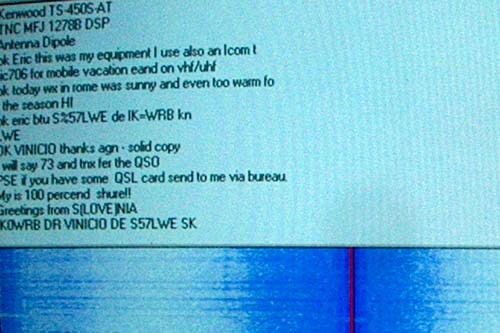

PSK means Phase Shifk Keying at 31 baud.
It is a digital communication mode, invented by Peter Martinez (G3PLX) and based
on the former SLOWBPSK, by Pawel Jalocha (SP9VRC).
It modulates the phase of a single audio tone, transmitted normally in
USB mode, on HF bands and
on six meters, or also in FM, on VHF
bands and up.
It exists in two variants:
| Code or Ascii char. | Bit sequence | Code or Ascii char. | Bit sequence |
|---|---|---|---|
| 0 | 1010101011 | 1 | 1011011011 |
| 2 | 1011101101 | 3 | 1101110111 |
| 4 | 1011101011 | 5 | 1101011111 |
| 6 | 1011101111 | 7 | 1011111101 |
| 8 | 1011111111 | 9 | 11101111 |
| line feed | 11101 | 11 | 1101101111 |
| 12 | 1011011101 | return | 11111 |
| 14 | 1101110101 | 15 | 1110101011 |
| 16 | 1011110111 | 17 | 1011110101 |
| 18 | 1110101101 | 19 | 1110101111 |
| 20 | 1101011011 | 21 | 1101101011 |
| 22 | 1101101101 | 23 | 1101010111 |
| 24 | 1101111011 | 25 | 1101111101 |
| 26 | 1110110111 | 27 | 1101010101 |
| 28 | 1101011101 | 29 | 1110111011 |
| 30 | 1011111011 | 31 | 1101111111 |
| space | 1 | ! | 111111111 |
| " | 101011111 | # | 111110101 |
| $ | 111011011 | % | 1011010101 |
| & | 1010111011 | ' | 101111111 |
| ( | 11111011 | ) | 11110111 |
| * | 101101111 | + | 111011111 |
| , | 1110101 | - | 110101 |
| . | 1010111 | / | 110101111 |
| 0 | 10110111 | 1 | 10111101 | 2 | 11101101 | 3 | 11111111 |
| 4 | 101110111 | 5 | 101011011 |
| 6 | 101101011 | 7 | 110101101 |
| 8 | 110101011 | 9 | 110110111 |
| : | 11110101 | ; | 110111101 |
| < | 111101101 | = | 1010101 |
| > | 111010111 | ? | 1010101111 |
| @ | 1010111101 | A | 1111101 |
| B | 11101011 | C | 10101101 |
| D | 10110101 | E | 1110111 |
| F | 11011011 | G | 11111101 |
| H | 101010101 | I | 1111111 |
| J | 111111101 | K | 101111101 |
| L | 11010111 | M | 10111011 |
| N | 11011101 | O | 10101011 |
| P | 11010101 | Q | 111011101 |
| R | 10101111 | S | 1101111 |
| T | 1101101 | U | 101010111 |
| V | 110110101 | W | 101011101 |
| X | 101110101 | Y | 101111011 |
| Z | 1010101101 | [ | 111110111 |
| \ | 111101111 | ] | 111111011 |
| ^ | 1010111111 | _ | 101101101 |
| ` | 1011011111 | a | 1011 |
| b | 1011111 | c | 101111 |
| d | 101101 | e | 11 |
| f | 111101 | g | 1011011 |
| h | 101011 | i | 1101 |
| j | 111101011 | k | 10111111 |
| l | 11011 | m | 111011 |
| n | 1111 | o | 111 |
| p | 111111 | q | 110111111 |
| r | 10101 | s | 10111 |
| t | 101 | u | 110111 |
| v | 1111011 | w | 1101011 |
| x | 11011111 | y | 1011101 |
| z | 111010101 | { | 1010110111 |
| | | 110111011 | } | 1010110101 |
| ~ | 1011010111 | 127 | 1110110101 |
| Bits | Shift | Bits | Shift | Bits | Shift | Bits | Shift |
|---|---|---|---|---|---|---|---|
| 00000 | 180° | 00001 | +90° | 00010 | -90° | 00011 | 0 |
| 00100 | -90° | 00101 | 0 | 00110 | 180° | 00111 | +90° |
| 01000 | 0 | 01001 | -90° | 01010 | +90° | 01011 | 180° |
| 01100 | +90° | 01101 | 180° | 01110 | 0 | 01111 | -90° |
| 10000 | +90° | 10001 | 180° | 10010 | 0 | 10011 | -90° |
| 10100 | 0 | 10101 | -90° | 10110 | +90° | 10111 | 180° |
| 11000 | -90° | 11001 | 0 | 11010 | 180° | 11011 | +90° |
| 11100 | 180° | 11101 | +90° | 11110 | -90° | 11111 | 0 |
